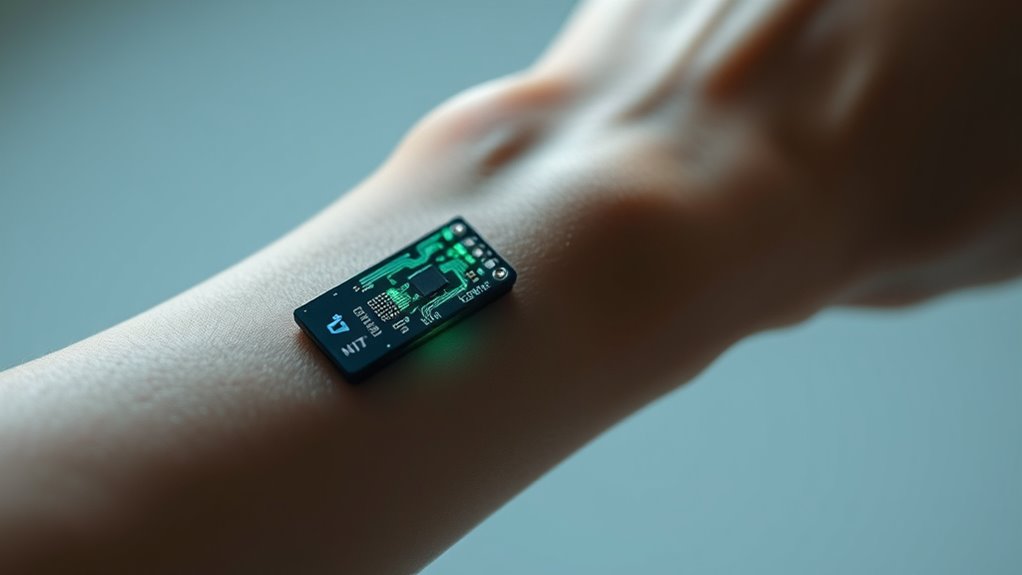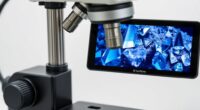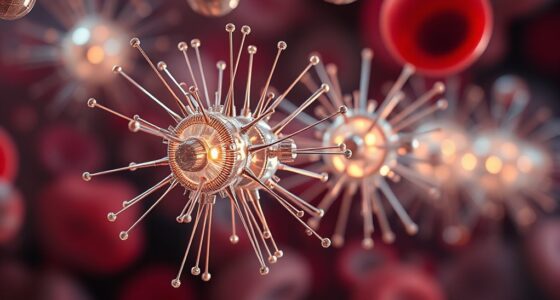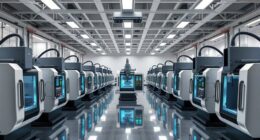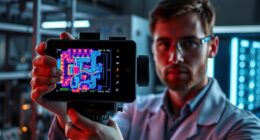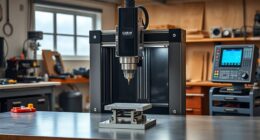Biosensors and wearable nanodevices are revolutionizing your health monitoring by delivering continuous, real-time data through advanced materials and miniaturized sensors. They include components like flexible sensors, microprocessors, and wireless modules that track essential signs, chemicals, and biological signals. These devices are designed for comfort and durability, but challenges like environmental factors and power management exist. Exploring these innovations reveals how future trends will make health care more personalized and accessible. Keep going to uncover how these cutting-edge tools can transform your wellness.
Key Takeaways
- Wearable nanodevices incorporate sensors, microprocessors, and connectivity modules for real-time, continuous health monitoring of vital signs and biomarkers.
- Advanced materials like graphene and flexible polymers enable comfortable, durable, and biocompatible wearable biosensors.
- Signal processing algorithms and machine learning enhance data accuracy, anomaly detection, and reliable health insights from biosensor data.
- Innovations focus on miniaturization, energy harvesting, and AI integration to develop smarter, more autonomous health monitoring devices.
- These technologies improve personalized healthcare by enabling early diagnosis, lifestyle adjustments, and reducing the need for frequent clinical visits.
The Evolution of Biosensing Technologies
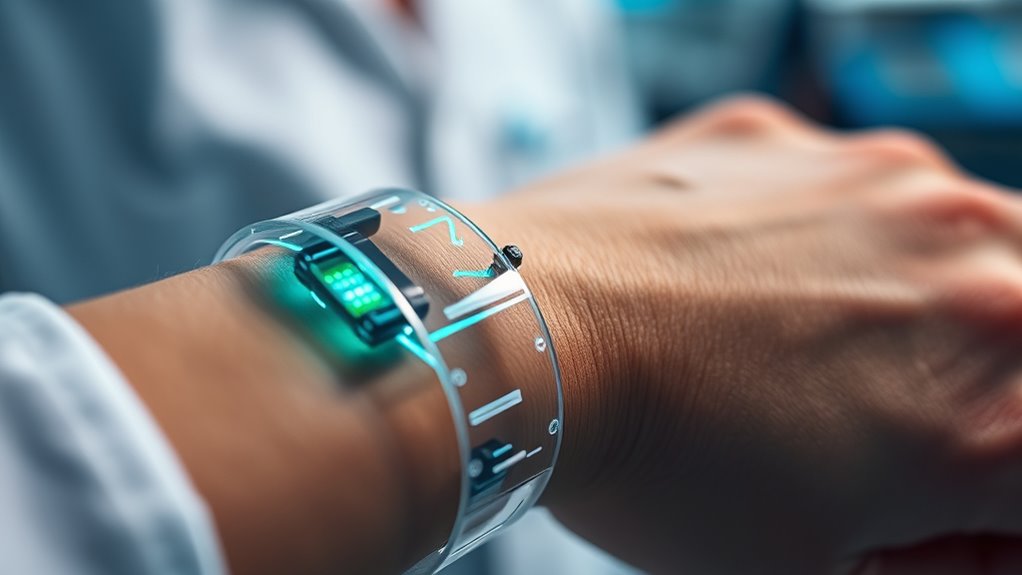
The evolution of biosensing technologies has transformed how you monitor health, moving from simple laboratory tests to advanced wearable devices. Initially, biosensors were limited to laboratory settings, requiring samples to be sent away for analysis. These early methods provided valuable information but lacked immediacy. Over time, innovations enabled miniaturization and increased sensitivity, leading to portable devices that deliver real-time data. Wearable biosensors now continuously track essential signs, glucose levels, and other health markers, providing instant feedback. This shift allows you to make timely decisions about your health, reducing the need for frequent doctor visits. As technology advances, biosensors are becoming more integrated, affordable, and user-friendly, making health monitoring accessible and personalized like never before. Additionally, ongoing research into vetted ID Times highlights the importance of reliability and safety standards in the development of these devices.
Key Components of Wearable Nanodevices

Wearable nanodevices rely on a combination of advanced components that work seamlessly to monitor your health in real time. At their core, they include sensors that detect physiological signals, such as heart rate or chemical levels. Microprocessors analyze this data instantly, providing meaningful insights. Power sources like compact batteries or energy harvesters keep the device operational without interruption. Flexible substrates and nanomaterials ensure comfort and durability during movement. Connectivity modules transmit data securely to your smartphone or healthcare provider. Here’s a breakdown of key components:
| Component | Function | Materials Used |
|---|---|---|
| Sensors | Detect biological signals | Graphene, gold |
| Microprocessors | Data processing and analysis | Silicon, CMOS |
| Power Sources | Supply energy | Lithium-ion, energy harvesters |
| Flexible Substrates | Support device flexibility | PDMS, polyimide |
| Connectivity Modules | Enable wireless communication | Bluetooth, NFC |
Types of Biosensors and Their Applications

Have you ever wondered how biosensors can detect specific health markers so accurately? Different types of biosensors serve various purposes in health monitoring. Electrochemical biosensors, for example, measure electrical signals generated by biological interactions, making them ideal for glucose monitoring. Optical biosensors use light to identify changes in specific molecules, useful in detecting biomarkers like proteins or hormones. Piezoelectric biosensors detect mass changes on their surface, often applied in pathogen detection. Enzymatic biosensors leverage enzyme reactions to identify target substances with high specificity. Each type offers unique advantages, from high sensitivity to rapid response times. These biosensors are essential tools in wearable devices, enabling continuous, real-time health data collection and early diagnosis, ultimately improving personalized healthcare and disease management. Advancements in biosensor technology continue to expand their capabilities in healthcare applications.
Materials and Fabrication of Wearable Devices
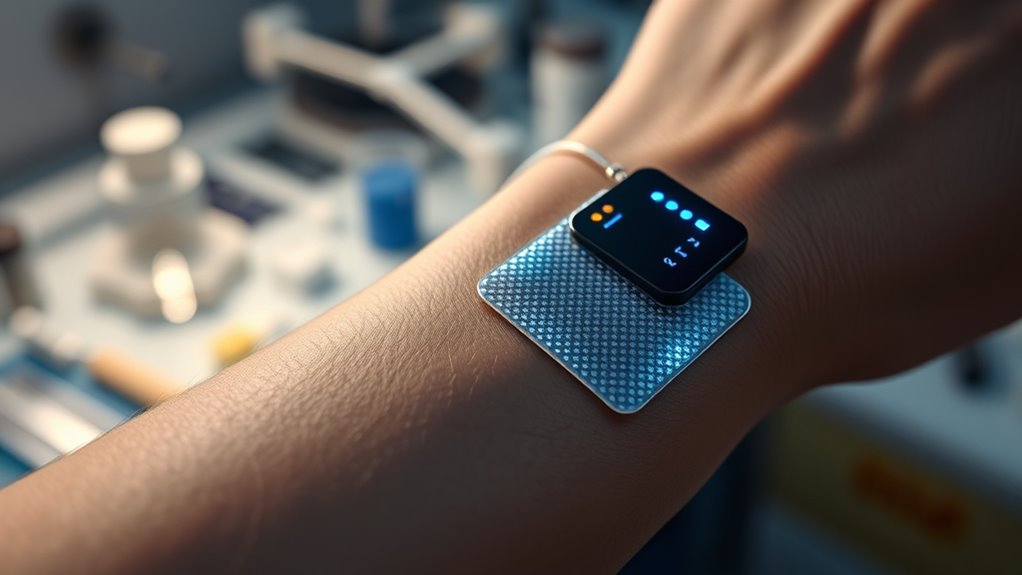
Advances in materials and fabrication techniques enable the development of flexible, lightweight, and durable wearable devices that conform comfortably to the body. You’ll find that emerging materials like flexible polymers, thin metals, and conductive textiles allow devices to bend, stretch, and move with you. You can also incorporate headphone jacks in designing versatile wearable interfaces for seamless connectivity. Fabrication methods such as inkjet printing, laser engraving, and microfabrication enable precise, scalable production of complex sensor architectures on flexible substrates. These techniques minimize bulk and enhance comfort, making wearables unobtrusive for everyday use. Incorporating nanomaterials like graphene and carbon nanotubes further improves flexibility and electrical performance. Overall, the combination of innovative materials and advanced manufacturing processes enables the creation of reliable, skin-friendly devices capable of continuous health monitoring without sacrificing comfort or durability.
Data Collection and Signal Processing
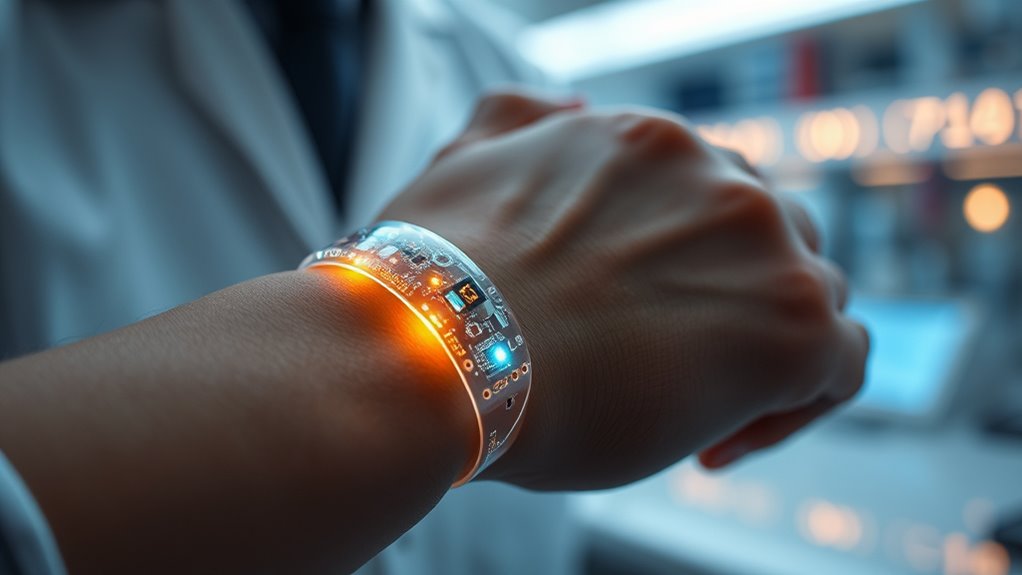
You need reliable signal acquisition techniques to gather accurate data from your wearable devices. Once collected, effective data analysis algorithms help interpret these signals quickly and accurately. Understanding these methods is essential for optimizing health monitoring performance. Recognizing the importance of inspirational quotes about fatherhood can also serve as a motivational reminder of the value of guidance and support in health management.
Signal Acquisition Techniques
Effective signal acquisition is essential for the accurate operation of biosensors and wearable nanodevices, as it involves capturing physiological data with minimal noise and interference. You should select appropriate sensors that match the specific signals you’re targeting, such as electrochemical, optical, or mechanical sensors. Proper placement is critical to guarantee reliable data collection, so position sensors where physiological signals are strongest. Amplification and filtering circuits are necessary to enhance signal quality, reducing unwanted noise before digitization. You’ll also need high-resolution analog-to-digital converters to accurately convert signals into digital data. Consistent calibration ensures measurement accuracy over time. Additionally, understanding sensor technology and its advancements can significantly improve data collection methods. By optimizing these techniques, you improve data fidelity, enabling precise health monitoring and reliable device performance.
Data Analysis Algorithms
To accurately interpret physiological signals from biosensors and wearable nanodevices, robust data collection and signal processing algorithms are essential. You need to guarantee that noisy, incomplete, or inconsistent data is filtered and cleaned effectively. Techniques like filtering, baseline correction, and artifact removal help you extract meaningful information. Signal processing algorithms transform raw data into usable formats, such as extracting features like heart rate variability or oxygen saturation levels. Machine learning models can classify patterns, detect anomalies, and predict health events based on processed data. Real-time analysis allows you to monitor health continuously and respond promptly to critical changes. By optimizing these algorithms, you improve the accuracy, reliability, and utility of wearable health devices, enabling better diagnosis, management, and personalized healthcare solutions. Additionally, integrating AI content clusters enhances the development of comprehensive and interconnected data analysis strategies, further elevating device performance and user outcomes.
Challenges and Limitations in Development
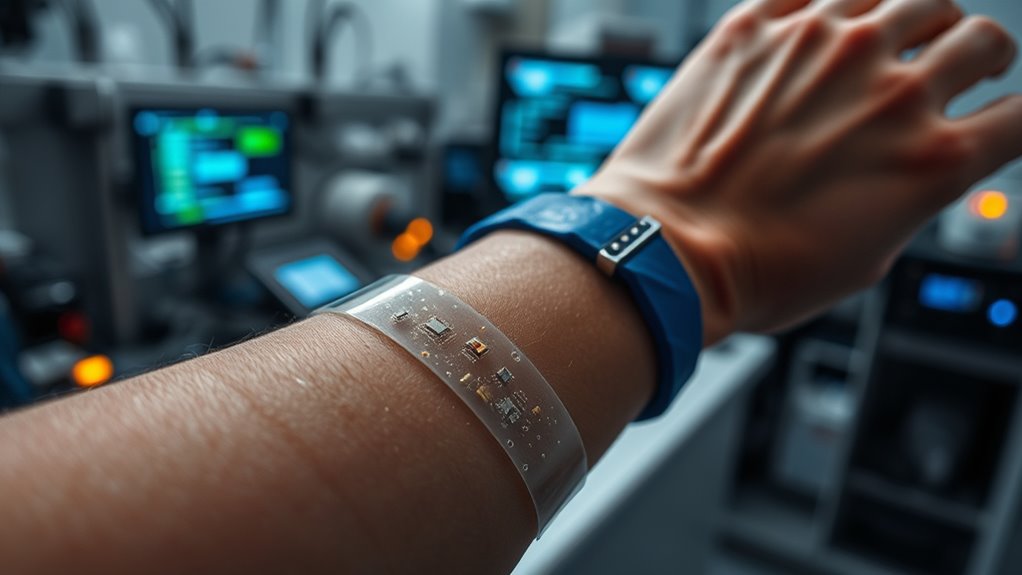
Despite significant advancements, developing biosensors and wearable nanodevices for health monitoring faces numerous challenges. One major hurdle is ensuring biocompatibility; materials must be safe for prolonged skin contact without causing irritation or immune responses. You also encounter issues with sensor stability and accuracy over time, especially when exposed to environmental factors like sweat, dust, or movement. Power management remains problematic—devices need long-lasting, lightweight batteries or energy-harvesting solutions to function continuously. Manufacturing at scale introduces variability, affecting consistency and reliability. Data privacy and security pose additional concerns, as sensitive health information must be protected against breaches. Overcoming these limitations requires innovative material choices, robust design, and strict quality controls to make wearable nanodevices viable for long-term health monitoring. Additionally, addressing sensor stability and accuracy challenges is essential for reliable health data collection over extended periods.
Future Trends and Innovations

The future of biosensors and wearable nanodevices is poised for rapid innovation, driven by advances in materials science, miniaturization, and data analytics. You’ll see smarter sensors that adapt to your body, providing more accurate and real-time health data. Integration with AI will enable predictive diagnostics, catching issues early. Flexible, biocompatible materials will make devices more comfortable and less intrusive. Additionally, energy harvesting from body movements will reduce battery dependence. As a result, wearables will become more autonomous, durable, and personalized. Advanced materials will play a crucial role in enhancing device performance and user comfort.
Impact on Healthcare and Personal Wellness
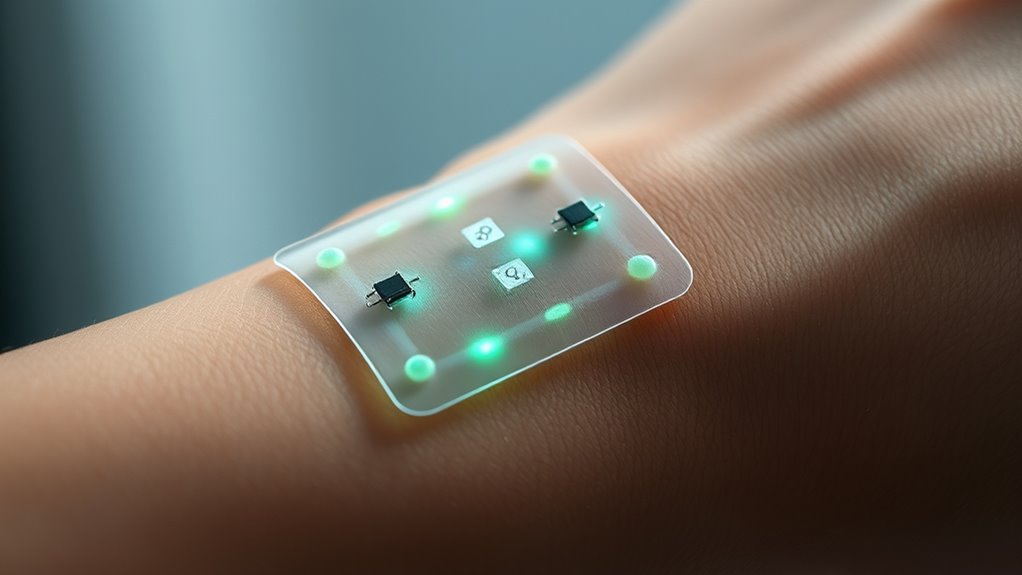
Advances in biosensors and wearable nanodevices are transforming healthcare and personal wellness by enabling real-time, continuous monitoring of essential signs and health metrics. You can now track your heart rate, glucose levels, sleep patterns, and hydration status with devices that provide instant feedback. This immediate insight helps you make informed decisions about your lifestyle, diet, and activity, reducing the risk of chronic diseases. Healthcare providers benefit too, as they get accurate, ongoing data to tailor treatments and catch issues early. Additionally, the development of high-precision sensor technology enhances the reliability and accuracy of these monitoring devices. Overall, these innovations empower you to take control of your health proactively. They foster a more personalized approach to wellness, promoting healthier habits and improving quality of life. This shift toward constant monitoring ultimately enhances both individual well-being and healthcare efficiency.
Frequently Asked Questions
How Do Biosensors Ensure Data Privacy and Security?
You can guarantee data privacy and security by using encryption to protect your health data during transmission and storage. Regular software updates, strong passwords, and two-factor authentication help prevent unauthorized access. Additionally, manufacturers often implement secure data protocols and anonymize your information to maintain privacy. Always review privacy policies and choose devices that prioritize data security, giving you peace of mind while monitoring your health.
What Are the Environmental Impacts of Wearable Nanodevices?
You might be concerned about the environmental impacts of wearable nanodevices, and it’s valid. These devices can generate electronic waste and contain materials that are hard to recycle or may be toxic if released into the environment. Manufacturing processes also consume energy and resources. To minimize your impact, choose devices from eco-friendly companies, properly recycle old gadgets, and stay informed about sustainable practices in the tech industry.
Can These Devices Be Customized for Individual Health Needs?
Yes, you can customize wearable nanodevices to suit your individual health needs. Manufacturers often offer options to tailor sensors for specific conditions, like glucose monitoring or heart rate tracking. You might also be able to adjust device settings or integrate personalized data for more accurate health insights. This customization helps you monitor your health more effectively, ensuring the device provides relevant and actionable information tailored just for you.
How Do Biosensors Perform in Extreme Weather Conditions?
Biosensors can struggle in extreme weather conditions, as high temperatures, humidity, or cold may influence their accuracy and durability. You might notice unreliable readings or device malfunctions in such environments. To guarantee consistent performance, look for biosensors specifically designed with protective coatings or temperature compensation features. Proper calibration and maintenance also help mitigate weather-related issues, so you can rely on your health monitoring devices regardless of weather challenges.
What Are the Cost Implications for Widespread Adoption?
Widespread adoption of biosensors and wearable nanodevices can be costly upfront, including R&D, manufacturing, and distribution expenses. However, as production scales up, costs tend to decrease, making devices more affordable. You might also face ongoing expenses like maintenance and data management. Ultimately, investing in these technologies could save money long-term by preventing health issues early and reducing healthcare costs.
Conclusion
As you explore the world of biosensors and wearable nanodevices, remember they’re the heartbeat of future healthcare, transforming lives like a lighthouse guiding ships through darkness. With ongoing innovations, you’ll witness a revolution in personal wellness and medical monitoring, making health tracking as natural as breathing. Embrace these advancements, because they’re shaping a healthier tomorrow where technology and well-being walk hand in hand, illuminating your path to better health.
